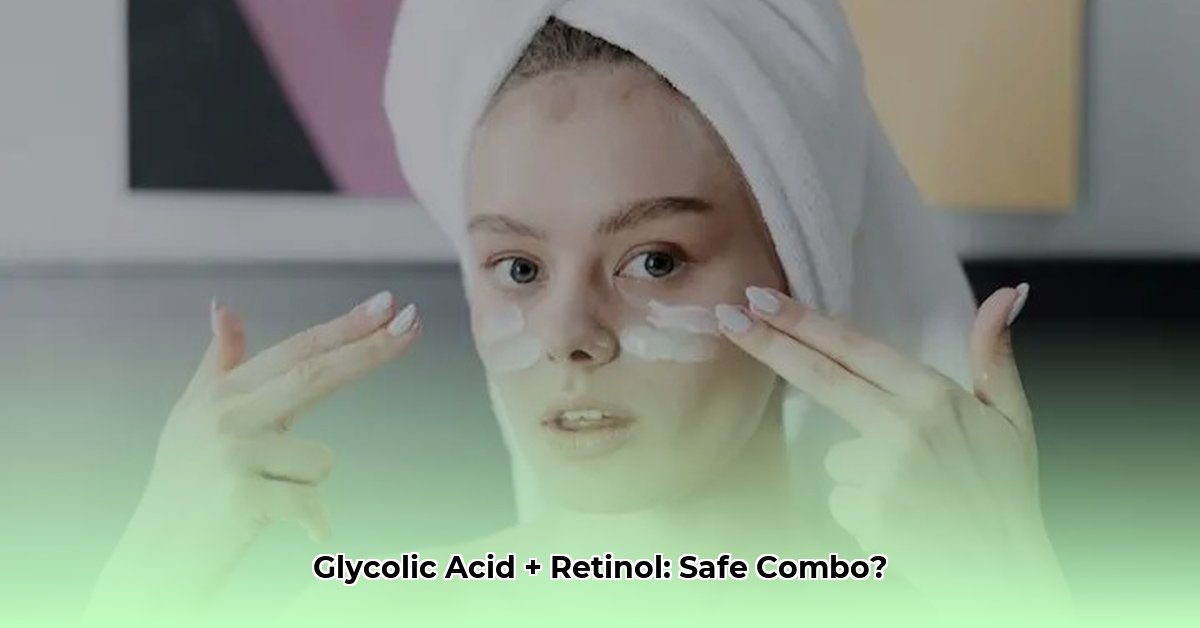Yes, you can use glycolic acid and retinol together, but it’s crucial to do so with caution. Combining these potent skincare ingredients can offer impressive results, but improper use can lead to irritation. This guide provides a safe, step-by-step approach to incorporating both into your routine.
How Glycolic Acid and Retinol Work
Let’s break down the science behind these skincare superheroes:
- Glycolic Acid: This alpha-hydroxy acid (AHA) acts as a chemical exfoliant, gently dissolving the “glue” that holds dead skin cells together. Think of it as a surface-level resurfacing agent, revealing brighter, smoother skin underneath.
- Retinol: A vitamin A derivative, retinol works at a deeper level. It boosts collagen production (essential for plump, youthful skin) and increases cell turnover, revealing fresh, new skin cells. Retinol is a long-term investment in your skin’s health.
An infographic illustrating the different layers of skin and where each ingredient works would be beneficial here.
Benefits of the Dynamic Duo
Combining glycolic acid and retinol can offer synergistic benefits:
- Enhanced Penetration: By exfoliating dead skin cells, glycolic acid paves the way for retinol to penetrate more deeply and effectively.
- Improved Tone and Texture: The combined action of these ingredients can lead to a smoother, more even skin tone and reduced appearance of fine lines, wrinkles, and acne scars.
- Brighter Complexion: Glycolic acid’s exfoliating action, coupled with retinol’s cell turnover boost, results in a noticeably brighter, more radiant complexion.
Before-and-after images could effectively demonstrate these benefits.
Risks and Precautions
While the potential benefits are exciting, caution is key:
- Increased Sun Sensitivity: Both ingredients make your skin more vulnerable to sun damage. Daily sunscreen use (SPF 30 or higher) is non-negotiable.
- Irritation: Overuse or improper combination can lead to dryness, redness, peeling, and even a burning sensation.
- Not for Everyone: Those with sensitive skin, rosacea, eczema, or who are pregnant or breastfeeding should consult a dermatologist before using retinol or combining it with glycolic acid.
Your Step-by-Step Guide to Combining Glycolic Acid and Retinol
- Patch Test: Apply a small amount of each product separately to a less visible area (inner arm or behind the ear). Wait 48 hours to observe for any reaction.
- Start Low and Slow: Begin with low concentrations of both ingredients (e.g., 5-10% glycolic acid, 0.25% retinol). Use each product only once or twice a week initially.
- Alternate Application: Never apply both ingredients simultaneously. Use glycolic acid in the morning and retinol at night, or alternate days.
- Buffering (Optional): For sensitive skin, apply retinol after your moisturizer to reduce potential irritation.
- Hydrate: Use a gentle, hydrating moisturizer morning and night to combat dryness.
- Protect: Apply broad-spectrum sunscreen every morning, rain or shine.
- Listen to Your Skin: If you experience excessive dryness, redness, or irritation, reduce the frequency or concentration of the products.
Quick Reference Guide
| Ingredient | Benefits | Potential Risks | How to Use | Starting Frequency |
|---|---|---|---|---|
| Glycolic Acid | Exfoliates, brightens, improves skin tone | Irritation, sun sensitivity | Cleanser, toner, serum | 1-2x/week |
| Retinol | Anti-aging, improves texture, treats acne | Irritation, dryness, sun sensitivity | Serum, cream | 1-2x/week |
Tips for Sensitive Skin
If you have sensitive skin:
- Consult a dermatologist before combining these ingredients.
- Start with even lower concentrations and increase frequency very gradually.
- Consider “buffering” retinol by applying it after moisturizer.
- Look for gentler formulations designed for sensitive skin.
Expert Insight
“Retinol and glycolic acid are potent ingredients that can deliver impressive results when used correctly,” says Dr. Ava Shamban, a board-certified dermatologist in Beverly Hills. “However, it’s essential to prioritize a slow and steady approach, especially for those new to these ingredients or with sensitive skin. Patch testing and consistent sunscreen use are crucial for minimizing the risk of irritation and maximizing the benefits.”
Product Recommendations (Optional – Examples)
- Budget-Friendly: The Ordinary Glycolic Acid 7% Toning Solution, CeraVe Resurfacing Retinol Serum
- Mid-Range: Paula’s Choice SKIN PERFECTING 8% AHA Gel Exfoliant, La Roche-Posay Retinol B3 Serum
(Note: Product recommendations should be tailored to your target audience and include relevant affiliate links if applicable.)
FAQs
- Can I use glycolic acid and retinol at the same time? No, applying them simultaneously can increase the risk of irritation. Alternate application is recommended.
- What should I do if I experience peeling or redness? Reduce the frequency of use or decrease the concentration of the products. If irritation persists, consult a dermatologist.
- How long will it take to see results? While some improvement may be noticeable within a few weeks, significant changes often take several months of consistent use.
Conclusion
Combining glycolic acid and retinol can be a highly effective way to achieve a healthier, more youthful complexion. However, it’s crucial to prioritize a cautious and gradual approach. By following the guidelines in this guide, patch testing, listening to your skin, and practicing diligent sun protection, you can harness the power of these skincare superheroes while minimizing potential risks. Remember, patience and consistency are key to unlocking the full potential of your skincare routine. If you have any concerns or specific skin conditions, consulting a dermatologist is always recommended. Ongoing research continues to shed light on the optimal use of these ingredients, so staying informed about the latest findings can further enhance your skincare journey.
- Why Glass Boxes for Lunch Are Trending for Meal Prep - December 17, 2025
- Bento Box Glass Offers Practical, Eco-Friendly Meal Storage - December 16, 2025
- The Best Bento Box Price For Your Perfect Packed Lunch - December 15, 2025










